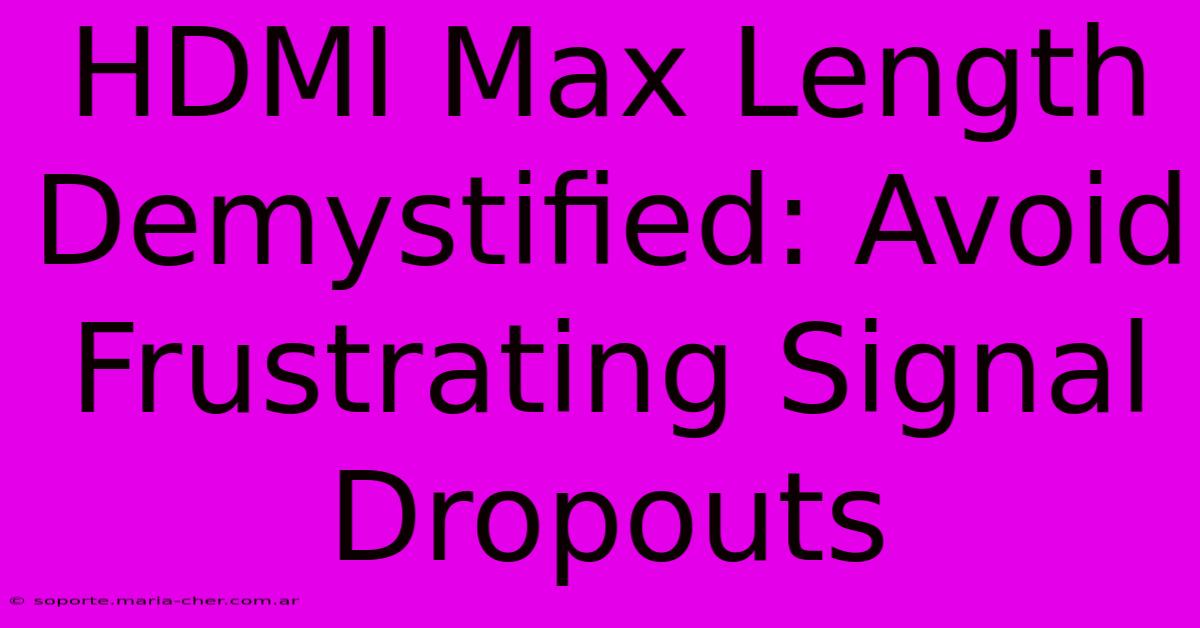HDMI Max Length Demystified: Avoid Frustrating Signal Dropouts

Table of Contents
HDMI Max Length Demystified: Avoid Frustrating Signal Dropouts
Are you struggling with signal dropouts when using your HDMI cable? Is the distance between your source device (like a Blu-ray player or game console) and your display (TV or projector) causing frustrating interruptions? You're not alone. Understanding HDMI's maximum length limitations is crucial for a smooth, high-definition viewing experience. This article demystifies HDMI cable length and offers solutions to avoid those annoying signal dropouts.
Understanding HDMI Signal Limitations
HDMI (High-Definition Multimedia Interface) is the gold standard for transmitting high-resolution video and audio signals. However, the maximum length of an HDMI cable before signal degradation occurs isn't a fixed number. It depends on several factors, including:
- HDMI Version: Older HDMI versions (like 1.0 and 1.1) have shorter maximum lengths than newer versions (e.g., 2.1). Newer versions are designed to handle higher bandwidths and longer distances.
- Cable Quality: A high-quality, certified HDMI cable is essential. Cheap, uncertified cables often fail at shorter distances. Look for cables that explicitly state their compliance with the HDMI specification and their bandwidth capabilities.
- Resolution and Refresh Rate: Higher resolutions (like 4K or 8K) and higher refresh rates (like 120Hz) demand more bandwidth, reducing the maximum cable length.
- Cable Gauge: Thicker cables (lower AWG number) generally perform better over longer distances. A thicker gauge cable has less resistance, leading to better signal transmission.
In short: There's no single "maximum HDMI length." While some might claim a specific number, it's a misleading oversimplification. Signal degradation is gradual, and it's influenced by the interconnected factors mentioned above.
Common Problems Caused by Exceeding HDMI Max Length
Exceeding the effective maximum length for your setup can lead to a variety of problems, including:
- Signal Dropouts: Intermittent loss of signal, resulting in flickering or complete black screens.
- Pixelation: Image quality suffers with distorted or blurry pixels.
- No Signal: The display might not recognize the source device entirely.
- Audio Issues: Sound distortion or loss of audio.
These problems are incredibly frustrating, especially during crucial moments of a movie or game.
Solutions to Extend HDMI Reach
If your HDMI cable needs to exceed the practical limits, several effective solutions exist:
1. HDMI Extenders
HDMI extenders are specialized devices that boost the signal, allowing you to use longer cables. They come in different types:
- Active HDMI Extenders: These use amplification to extend the signal, and are generally required for longer runs (50+ feet).
- Passive HDMI Extenders: These are simpler, but only effective for shorter distances.
Choosing the right extender depends on the distance required. Always check the specifications to ensure it supports the resolution and bandwidth you need.
2. HDMI Over Cat5/Cat6 Extenders
These extenders transmit the HDMI signal over standard Cat5e or Cat6 Ethernet cables. This approach allows significantly longer distances than standard HDMI cables. They usually involve a transmitter connected to your HDMI source and a receiver connected to your display.
3. Wireless HDMI Transmitters and Receivers
For a truly wireless solution, you can utilize wireless HDMI transmitters and receivers. These transmit the signal over Wi-Fi or another wireless protocol. While convenient, they can sometimes introduce latency (delay), so they are not ideal for gaming.
Choosing the Right Solution:
The best solution depends on your specific needs:
- Short distances (under 25ft): A high-quality, certified HDMI cable is usually sufficient.
- Medium distances (25-50ft): An active HDMI extender might be necessary.
- Long distances (over 50ft): An HDMI over Cat5/Cat6 extender or a wireless solution is generally needed.
Remember to always check the specifications of any extender or cable to ensure compatibility with your devices and desired resolution/refresh rate. Investing in quality equipment will prevent future headaches and ensure a consistently satisfying viewing experience. Don't let signal dropouts ruin your entertainment!

Thank you for visiting our website wich cover about HDMI Max Length Demystified: Avoid Frustrating Signal Dropouts. We hope the information provided has been useful to you. Feel free to contact us if you have any questions or need further assistance. See you next time and dont miss to bookmark.
Featured Posts
-
Beyond Helvetica Discover The Art Of Custom Typography
Feb 06, 2025
-
Broncano Y Sanchez Gijon Discusion Sobre
Feb 06, 2025
-
Politicos Late Payments A Musk Effect
Feb 06, 2025
-
Islamic Architectures Aga Khan Dead At 88
Feb 06, 2025
-
Roll For Critical Hits Unlock D And D Nail Designs That Will Stun
Feb 06, 2025
